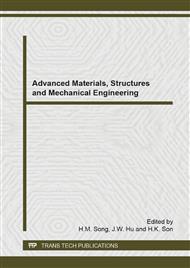p.208
p.215
p.221
p.227
p.233
p.241
p.246
p.251
p.256
Simulation Analysis of In-Service Bamboo and Pine EGP Composite Flooring
Abstract:
Bamboo is a renewable material that has been gaining attention in several sectors of production and research because of its potential. Its special characteristics of rapid growth, short harvest cycle, diversity and excellent mechanical properties. The objective of this work was a physical-mechanical analysis of flooring manufactured by a combination of bamboo (Dendrocalamus giganteus) laminate slats and wood (Pinus taeda) edge-glued panels (EGP). It was based on the ASTM D2394-83/1994 standard, which describes the procedures for mechanical simulation of in-service floors, such as indentation loads applied on small areas, falling ball impact, rolling load, abrasion and friction tests. The results were satisfactory when compared with those of other types of wood. The research showed lignocellulosic composite of Pine EGP with a bamboo surface, in terms of mechanical strength according the ASTM’s standard, is viable and feasible. Therefore, it results that “EGP/Bamboo” composite can be successfully applied for internal floors.
Info:
Periodical:
Pages:
233-240
Citation:
Online since:
September 2014
Keywords:
Price:
Сopyright:
© 2014 Trans Tech Publications Ltd. All Rights Reserved
Share:
Citation:


